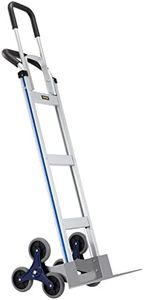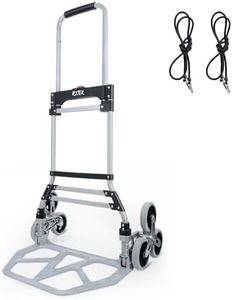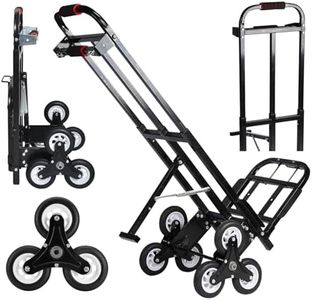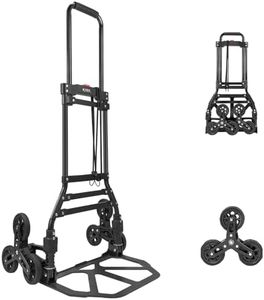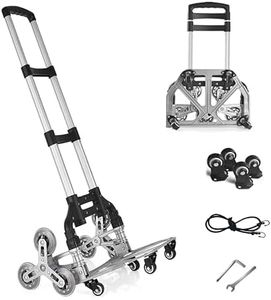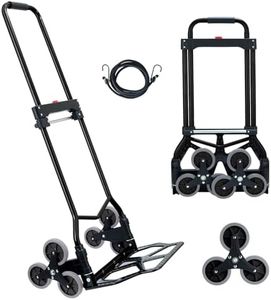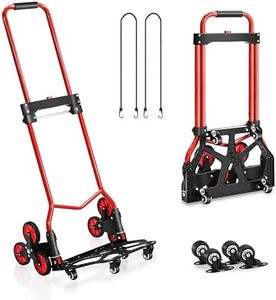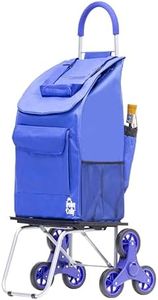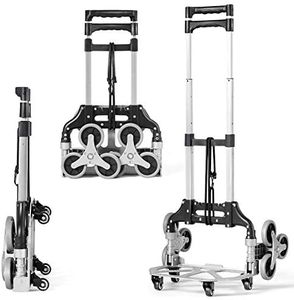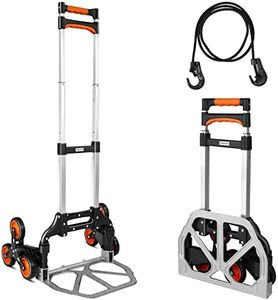We Use CookiesWe use cookies to enhance the security, performance,
functionality and for analytical and promotional activities. By continuing to browse this site you
are agreeing to our privacy policy
10 Best Stair Climbing Hand Trucks
From leading brands and best sellers available on the web.Buying Guide for the Best Stair Climbing Hand Trucks
Choosing a stair-climbing hand truck is all about matching the tool to your physical needs and the type of loads you'll be moving. Stair-climbing hand trucks are specially designed to help you transport heavy or bulky items up and down stairs with less strain and risk of injury. Each model offers unique features, so it's important to focus on how you’ll use it—what kinds of items you plan to move, how often you’ll use it, and the kind of stairs you'll encounter. Understanding specs like weight capacity, wheel type, frame material, handle design, and foldability will help you decide which hand truck will become a helpful companion rather than an awkward burden.Weight CapacityWeight capacity indicates the maximum load the stair-climbing hand truck can safely carry; it's crucial because exceeding this limit can damage the truck or injure you. Typically, these capacities range from about 100 to over 500 pounds. Light use models are fine for boxes or small appliances, while heavier duty trucks are designed for larger furniture or equipment. To pick the right one, consider the heaviest item you’ll need to move and ensure the hand truck's capacity exceeds that to provide a safety margin.
Stair-Climbing Mechanism/Wheel ConfigurationThe core of a stair-climbing hand truck is its wheel setup—usually clusters of three wheels on each side, allowing for a rolling, climbing action up and down stairs. There are variations: some models use robust tri-wheel clusters, while others feature more complex mechanisms. Simpler tri-wheel clusters suit standard stairs, while advanced mechanisms help with steep, uneven, or outdoor steps. Choose based on the kind of stairs you face most often; basic clusters for uniform, indoor steps, and more robust systems for irregular, outdoor or taller steps.
Frame MaterialThe frame material affects both durability and weight of the hand truck. Common options are steel, aluminum, or a mix of both. Steel frames are strong but heavier, suited for frequent heavy lifting, while aluminum is much lighter and easier to carry but may handle lower weights. If you'll be lifting the truck itself often, for example into vehicles, or using it for lighter loads, prioritize aluminum. For heavy, tough jobs and less need to lift the truck's own weight, steel might be better.
Handle Design and AdjustabilityHandle style and adjustability impact comfort and control when using the hand truck, especially for stairs. Fixed handles can provide stable leverage but may not suit all user heights, while telescoping or height-adjustable handles can adapt to different users and loads. Some handles are designed for two-handed use for heavy loads, while others are single-handed. If you are taller or shorter than average, or if multiple people will use the hand truck, adjustable handles can make the task much easier and more ergonomic.
Foldability and StorageFoldability refers to whether the hand truck collapses or folds for more compact storage, which is important if you have limited space or want the option of transporting it in a car. Some models are fully collapsible, while others may only have a folding toe plate. If you'll occasionally store or transport the hand truck or have minimal storage space, a folding design offers a big convenience; if you'll leave it assembled in one location, a non-folding, heavier-duty version may be fine.
Toe Plate SizeThe toe plate is the part of the hand truck that slides under the item to lift it. Size matters because a larger plate can support bigger and bulkier items, while a smaller one is lighter and easier to use in tight spaces. Think about the typical size of loads you’ll carry. If you’re moving boxes or smaller appliances, a compact plate is fine. For large, awkwardly shaped loads like furniture, a bigger toe plate provides the necessary support.
